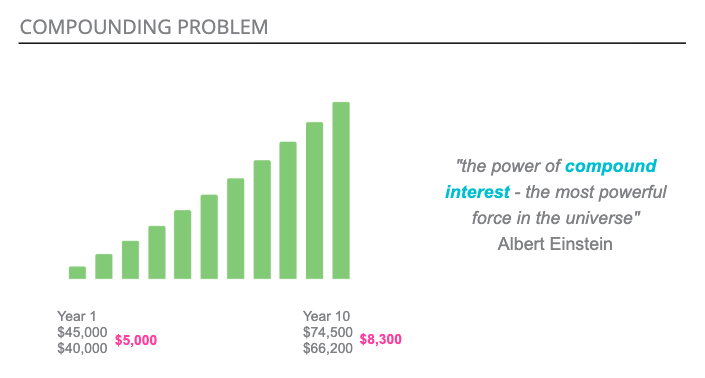
Part I: Why don’t women ask? Bridging the gender pay gap
It’s an even sadder story in the tech industry, with the gap still sitting at 18.5%, (0.5% higher than last year), and according to the Honeypot 2018 women in tech index, Australia is yet to make it into the top 20 countries offering best opportunities for women in tech.
The gender pay gap remains a compounding problem. Let’s say, for example, that both a man and woman are offered the same position for $40,000 a year. The woman accepts while the man negotiates his offer to $45,000. So he’s receiving $5000 a year more for the same job, which means after 10 years he has earned $50,000 more, right?
Wrong. Say, for argument's sake, that they both receive annual pay rises of 3%. After 10 years he is now earning $74,500 and she is earning $66,200. The difference in pay has opened up to $8,300 a year which is actually $64,000 over 10 years – and will grow exponentially.

However, this is a conservative example with stock pay rises and excluding other gendered issues such as career progression, career breaks, female-dominated industries paying less, unconscious bias and the fact that men are more likely to ask for pay rises and promotions regardless of their experience.
Studies have shown that women are less likely to negotiate and settle for what is given, whereas in a similar situation 57% of their male counterparts—or eight times as many men as women.
So what needs to happen for women to achieve equality in the workplace without taking a century to do it? How can we as individuals ensure we are being paid fairly? What are the responsibilities of those around us, and of our organisations to help close this gap?
Let’s look at it from three perspectives (organisations, managers, and individuals) and the steps we can take to ensure women are not only paid fairly but given adequate support to progress in their careers.
What can organisations be doing?
Gender equality can be difficult to recognise at an individual level, so organisations have a critical role to play to impact and influence the industry and mitigate the gender pay gap. Not only do they need to look at their processes holistically and commit to taking action on an ongoing basis, but they can also use data to drive their insights and decisions.1. Looking at data patterns
Last year only 37.7% of organisations completed a pay gap analysis of their people. Looking at data patterns in your organisation can help guide and better define policies by asking some simple questions:- On average how long does it take women to progress in comparison to men?
- How long do women and men stay in your organisation?
- How often do women leave for better pay or flexible working?
- When you run training sessions, who attends these?
- What is your gender pay gap trend at each grade level?
Regular analysis of this data will set the benchmark for more informed and objective decisions and provide visibility of changes over time as will tracking gender at each grade and role level. Regular data reviews will ensure the gender pay gap does not creep back in, and creates space for fair and reasonable one-off adjustments if required.
2. Salary transparency
As an organisation, do you share salary bands or data that will help employees understand where they stand compared to their peers, and what can they ask for? At Thoughtworks Australia, we publish salary ranges for each grade, which can be used as a guide for salary conversations. The gender pay gap data points across the grade are also published, and these data points are helpful for women to confidently asking for what they are worth.
3. A supportive leadership team
A supportive leadership team is key to building a culture of diversity. Being a people manager may not be natural to everyone, so regular training to support managers to improve their soft skills, understanding biases and increasing cultural awareness is important.
4. Create equal opportunities and expectations
Setting the stage for equal opportunities and expectations for women is pivotal. If an organisation is not providing equal opportunities to women, it is going to be challenging to assess fairly and objectively when it comes to performance. Despite parallel education and experience, women continue to miss out on leadership roles.
The statistics from WGEA speak for themselves, where almost 70% of key management roles have men appointed and only 28% of ASX organisation have women in leadership.
In addition, managing equal expectations for men around parental leave, work/life balance, and family expectations is important. In Australia men traditionally get only a few weeks of parental leave (as non-primary care-givers), while countries like Sweden apply a ‘use it or lose it’ approach that makes parental leave non-transferable and ensures both parents take that all important time off. This step mitigates only women taking career breaks which are a big reason for career trajectory slowing down.
At the end of the day, low numbers of women in the recruitment pipeline is often the excuse for not having diverse numbers in the workplace, however many organisations have started thinking outside the box when it comes to recruiting like hiring on potential and not just experience or qualifications or hiring from other industries with crossover skills. Additionally, clear growth strategies are just as important to empowering women to attain leadership roles with clear steps for career progression and support available early.
In part two we’ll look at unconscious bias and the importance of a manager’s support during the negotiation process.
Disclaimer: The statements and opinions expressed in this article are those of the author(s) and do not necessarily reflect the positions of Thoughtworks.

















